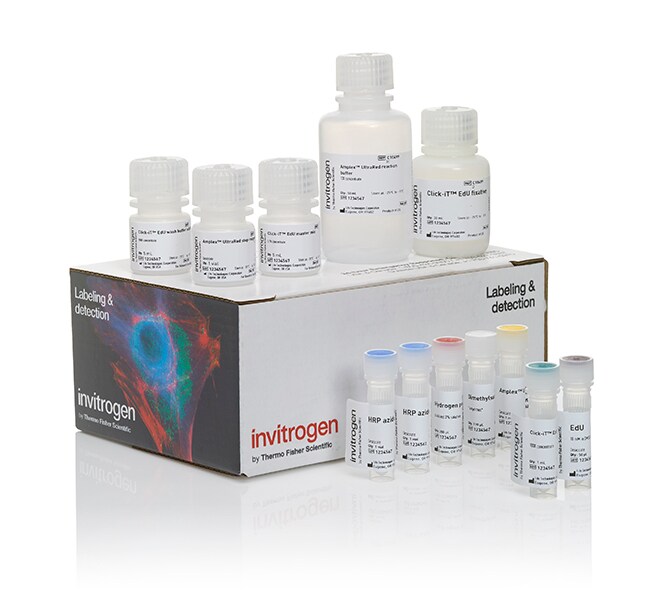Search Thermo Fisher Scientific
Invitrogen™
Click-iT™ EdU Proliferation Assay for Microplates
Catalog number: C10499
Have Questions? 
Invitrogen™
Click-iT™ EdU Proliferation Assay for Microplates
Catalog number: C10499
Have Questions? Catalog Number
C10499
Unit Size
400 assays
Price (USD)
813.65 Online price
828.00
Availability
-
Quantity
| Catalog Number | Unit Size | Price (USD) | Availability | Quantity | |
|---|---|---|---|---|---|
| C10499 | 400 assays | 813.65 Online price 828.00 | - |
Product Overview
Figures
Videos
Recommendations
Recommendations
Documents
FAQ
Citations & References
Additional Information
Recommendations
The Click-iT EdU Proliferation Assay for Microplates provides a more simplified and robust method for the measurement of mammalian cell proliferation compared to traditional BrdU-based methods. After incorporation of EdU (a modified thymidine analogue) into newly synthesize DNA, horse radish peroxidase (HRP) is covalently attached via the highly specific click reaction. Amplex UltraRed Reagent, an HRP substrate, is then added and the resulting fluorescence signal detected. Because of the highly specific attachment of HRP to EdU, this assay results in highly sensitive and reliable measurement of mammalian cell proliferation in a microplate format.
Click-iT EdU Proliferation Assay for Microplates features include:
• Improved performance—direct conjugation of HRP to incorporated EdU improves assay sensitivity and accuracy
• Increased reliability—assay format results in low well-to-well variability
• Simplified protocol—results in reduced time to data; easier to follow protocol
• Multiplex enabled—assay can be easily multiplexed with other cell health reagents resulting in more data per sample
Measuring cell proliferation is a fundamental method of assessing cell health, determining genotoxicity, and evaluating anti-cancer drugs. The most accurate method of measuring proliferation is by direct detection of DNA synthesis. Originally this was accomplished through incorporation of a radioactive nucleoside (e.g., 3H-thymidine). This method was replaced by antibody-based detection of the nucleoside analog bromo-deoxyuridine (BrdU). After incorporation of BrdU into the newly synthesized DNA, denaturation is required to expose the BrdU molecules to the anti-BrdU antibody. The denaturation involves harsh methods (HCl, heat, or enzymes) and is time consuming and difficult to perform consistently.
The Click-iT EdU Proliferation Assay is an alternative to the BrdU assay. The nucleoside analog EdU (5-ethynyl-2´-deoxyuridine) is added to live cells and incorporated into DNA during active DNA synthesis. The incorporated EdU contains an alkyne group which is covalently joined to the azide group present in HRP using a highly specific copper-catalyzed covalent reaction ('click reaction'). Amplex UltraRed Reagent is then added and its conversion by HRP into a highly fluorescent product is recorded using a fluorescence microplate reader (excitation: 568, emission: 585 nm). With a high extinction coefficient, good quantum efficiency, and resistance to auto-oxidation, Amplex UltraRed Reagent delivers higher sensitivity and a broader assay range than other fluorogenic or colorimetric HRP substrates. It also offers versatility through detection by either fluorescence or absorbance measurement.
Compared to anti-BrdU-based microplate proliferation assays, the Click-iT EdU Proliferation Assay uses small reaction moieties and does not require antibodies or DNA denaturation, both of which can reduce assay performance. Additionally, streptavidin-biotin binding is not required, eliminating the necessary biotin blocking steps required by cells possessing high levels of endogenous biotin.
Click-iT EdU Proliferation Assay for Microplates features include:
• Improved performance—direct conjugation of HRP to incorporated EdU improves assay sensitivity and accuracy
• Increased reliability—assay format results in low well-to-well variability
• Simplified protocol—results in reduced time to data; easier to follow protocol
• Multiplex enabled—assay can be easily multiplexed with other cell health reagents resulting in more data per sample
Measuring cell proliferation is a fundamental method of assessing cell health, determining genotoxicity, and evaluating anti-cancer drugs. The most accurate method of measuring proliferation is by direct detection of DNA synthesis. Originally this was accomplished through incorporation of a radioactive nucleoside (e.g., 3H-thymidine). This method was replaced by antibody-based detection of the nucleoside analog bromo-deoxyuridine (BrdU). After incorporation of BrdU into the newly synthesized DNA, denaturation is required to expose the BrdU molecules to the anti-BrdU antibody. The denaturation involves harsh methods (HCl, heat, or enzymes) and is time consuming and difficult to perform consistently.
The Click-iT EdU Proliferation Assay is an alternative to the BrdU assay. The nucleoside analog EdU (5-ethynyl-2´-deoxyuridine) is added to live cells and incorporated into DNA during active DNA synthesis. The incorporated EdU contains an alkyne group which is covalently joined to the azide group present in HRP using a highly specific copper-catalyzed covalent reaction ('click reaction'). Amplex UltraRed Reagent is then added and its conversion by HRP into a highly fluorescent product is recorded using a fluorescence microplate reader (excitation: 568, emission: 585 nm). With a high extinction coefficient, good quantum efficiency, and resistance to auto-oxidation, Amplex UltraRed Reagent delivers higher sensitivity and a broader assay range than other fluorogenic or colorimetric HRP substrates. It also offers versatility through detection by either fluorescence or absorbance measurement.
Compared to anti-BrdU-based microplate proliferation assays, the Click-iT EdU Proliferation Assay uses small reaction moieties and does not require antibodies or DNA denaturation, both of which can reduce assay performance. Additionally, streptavidin-biotin binding is not required, eliminating the necessary biotin blocking steps required by cells possessing high levels of endogenous biotin.
For Research Use Only. Not for use in diagnostic procedures.
Specifications
Detection Method
Fluorescent
For Use With (Application)
Proliferation Assay
For Use With (Equipment)
Microplate Reader
Product Type
Proliferation Assay
Format
96-well plate
Green Features
Less hazardous
Product Line
CyQUANT™
Shipping Condition
Approved for shipment at Room Temperature or on Wet Ice
Contents & Storage
Store at -20°C, desiccated and protected from light.
Figures
Documents & Downloads
Certificates
Search by lot number or partial lot number
Frequently asked questions (FAQs)
Citations & References
Search citations by name, author, journal title or abstract text